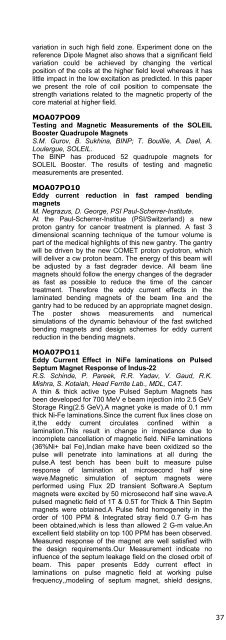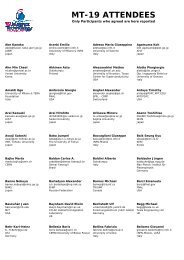Click here to download the abstract booklet in pdf format - MT19 - Infn
Click here to download the abstract booklet in pdf format - MT19 - Infn
Click here to download the abstract booklet in pdf format - MT19 - Infn
Create successful ePaper yourself
Turn your PDF publications into a flip-book with our unique Google optimized e-Paper software.
variation <strong>in</strong> such high field zone. Experiment done on <strong>the</strong><br />
reference Dipole Magnet also shows that a significant field<br />
variation could be achieved by chang<strong>in</strong>g <strong>the</strong> vertical<br />
position of <strong>the</strong> coils at <strong>the</strong> higher field level w<strong>here</strong>as it has<br />
little impact <strong>in</strong> <strong>the</strong> low excitation as predicted. In this paper<br />
we present <strong>the</strong> role of coil position <strong>to</strong> compensate <strong>the</strong><br />
strength variations related <strong>to</strong> <strong>the</strong> magnetic property of <strong>the</strong><br />
core material at higher field.<br />
MOA07PO09<br />
Test<strong>in</strong>g and Magnetic Measurements of <strong>the</strong> SOLEIL<br />
Booster Quadrupole Magnets<br />
S.M. Gurov, B. Sukh<strong>in</strong>a, BINP; T. Bouillie, A. Dael, A.<br />
Loulergue, SOLEIL.<br />
The BINP has produced 52 quadrupole magnets for<br />
SOLEIL Booster. The results of test<strong>in</strong>g and magnetic<br />
measurements are presented.<br />
MOA07PO10<br />
Eddy current reduction <strong>in</strong> fast ramped bend<strong>in</strong>g<br />
magnets<br />
M. Negrazus, D. George, PSI Paul-Scherrer-Institute.<br />
At <strong>the</strong> Paul-Scherrer-Institue (PSI/Switzerland) a new<br />
pro<strong>to</strong>n gantry for cancer treatment is planned. A fast 3<br />
dimensional scann<strong>in</strong>g technique of <strong>the</strong> tumour volume is<br />
part of <strong>the</strong> medical highlights of this new gantry. The gantry<br />
will be driven by <strong>the</strong> new COMET pro<strong>to</strong>n cyclotron, which<br />
will deliver a cw pro<strong>to</strong>n beam. The energy of this beam will<br />
be adjusted by a fast degrader device. All beam l<strong>in</strong>e<br />
magnets should follow <strong>the</strong> energy changes of <strong>the</strong> degrader<br />
as fast as possible <strong>to</strong> reduce <strong>the</strong> time of <strong>the</strong> cancer<br />
treatment. T<strong>here</strong>fore <strong>the</strong> eddy current effects <strong>in</strong> <strong>the</strong><br />
lam<strong>in</strong>ated bend<strong>in</strong>g magnets of <strong>the</strong> beam l<strong>in</strong>e and <strong>the</strong><br />
gantry had <strong>to</strong> be reduced by an appropriate magnet design.<br />
The poster shows measurements and numerical<br />
simulations of <strong>the</strong> dynamic behaviour of <strong>the</strong> fast switched<br />
bend<strong>in</strong>g magnets and design schemes for eddy current<br />
reduction <strong>in</strong> <strong>the</strong> bend<strong>in</strong>g magnets.<br />
MOA07PO11<br />
Eddy Current Effect <strong>in</strong> NiFe lam<strong>in</strong>ations on Pulsed<br />
Septum Magnet Response of Indus-22<br />
R.S. Sch<strong>in</strong>de, P. Pareek, R.R. Yadav, V. Gaud, R.K.<br />
Mishra, S. Kotaiah, Head Ferrite Lab., MDL, CAT.<br />
A th<strong>in</strong> & thick active type Pulsed Septum Magnets has<br />
been developed for 700 MeV e beam <strong>in</strong>jection <strong>in</strong><strong>to</strong> 2.5 GeV<br />
S<strong>to</strong>rage R<strong>in</strong>g(2.5 GeV).A magnet yoke is made of 0.1 mm<br />
thick Ni-Fe lam<strong>in</strong>ations.S<strong>in</strong>ce <strong>the</strong> current flux l<strong>in</strong>es close on<br />
it,<strong>the</strong> eddy current circulates conf<strong>in</strong>ed with<strong>in</strong> a<br />
lam<strong>in</strong>ation.This result <strong>in</strong> change <strong>in</strong> impedance due <strong>to</strong><br />
<strong>in</strong>complete cancellation of magnetic field. NiFe lam<strong>in</strong>ations<br />
(36%Ni+ bal Fe),Indian make have been oxidized so <strong>the</strong><br />
pulse will penetrate <strong>in</strong><strong>to</strong> lam<strong>in</strong>ations at all dur<strong>in</strong>g <strong>the</strong><br />
pulse.A test bench has been built <strong>to</strong> measure pulse<br />
response of lam<strong>in</strong>ation at microsecond half s<strong>in</strong>e<br />
wave.Magnetic simulation of septum magnets were<br />
performed us<strong>in</strong>g Flux 2D transient Software.A Septum<br />
magnets were excited by 50 microsecond half s<strong>in</strong>e wave.A<br />
pulsed magnetic field of 1T & 0.5T for Thick & Th<strong>in</strong> Septm<br />
magnets were obta<strong>in</strong>ed.A Pulse field homogeneity <strong>in</strong> <strong>the</strong><br />
order of 100 PPM & Integrated stray field 0.7 G-m has<br />
been obta<strong>in</strong>ed,which is less than allowed 2 G-m value.An<br />
excellent field stability on <strong>to</strong>p 100 PPM has been observed.<br />
Measured response of <strong>the</strong> magnet are well satisfied with<br />
<strong>the</strong> design requirements.Our Measurement <strong>in</strong>dicate no<br />
<strong>in</strong>fluence of <strong>the</strong> septum leakage field on <strong>the</strong> closed orbit of<br />
beam. This paper presents Eddy current effect <strong>in</strong><br />
lam<strong>in</strong>ations on pulse magnetic field at work<strong>in</strong>g pulse<br />
frequency,,model<strong>in</strong>g of septum magnet, shield designs,<br />
fabrication techniques, distribution of stray field outside of<br />
septum & pulse magnetic field homogenity <strong>in</strong> gap of<br />
Septum magnets.<br />
MOA07PO12<br />
Fabrication and Test<strong>in</strong>g of a Comb<strong>in</strong>ed<br />
Superconduct<strong>in</strong>g Magnet for <strong>the</strong> TESLA Test Facility<br />
F. Toral, P. Abramian, J.L. Gutierrez, E. Rodriguez, S.<br />
Sanz, C. Vazquez, CIEMAT; L. Garcia-Tabares, J. Calero,<br />
CEDEX; H. Brueck, W. Maschmann, DESY.<br />
An <strong>in</strong>ternational collaboration at DESY is currently study<strong>in</strong>g<br />
<strong>the</strong> possibilities of a new type of particle accelera<strong>to</strong>r: <strong>the</strong><br />
superconduct<strong>in</strong>g l<strong>in</strong>ear collider, developed under <strong>the</strong><br />
project name TESLA. The TESLA Test Facility is try<strong>in</strong>g <strong>to</strong><br />
establish a well-developed collider design, which will also<br />
be helpful for <strong>the</strong> design of a superconduct<strong>in</strong>g X-Ray Free<br />
Electron Laser facility, a project approved by <strong>the</strong> German<br />
Government and now <strong>in</strong> its <strong>in</strong>itial stage. This paper is about<br />
<strong>the</strong> fabrication and test<strong>in</strong>g of <strong>the</strong> first pro<strong>to</strong>type of a<br />
comb<strong>in</strong>ed superconduct<strong>in</strong>g magnet for focus<strong>in</strong>g and<br />
steer<strong>in</strong>g purposes, <strong>in</strong> <strong>the</strong> framework of <strong>the</strong> Spanish<br />
contribution <strong>to</strong> TESLA project. It consists of a quadrupole<br />
and two dipole concentric coils, one horizontal and ano<strong>the</strong>r<br />
one, vertical. The double pancake w<strong>in</strong>d<strong>in</strong>g technique with a<br />
ribbon of eight pre-glued wires has been used <strong>in</strong> order <strong>to</strong><br />
develop a cheap method for <strong>in</strong>dustrial scale, as <strong>the</strong><br />
accelera<strong>to</strong>r would need about 800 magnets. The coils were<br />
fully <strong>in</strong>strumented with voltage taps <strong>to</strong> study <strong>the</strong> quench<br />
start<strong>in</strong>g location. The magnet has been successfully tested<br />
at DESY and <strong>the</strong> results are presented <strong>in</strong> this paper.<br />
POSTER SESSION 13:30 – 15:30<br />
MAGNET MEASUREMENTS<br />
MOA08PO01<br />
A Rotat<strong>in</strong>g Coil Apparatus with Sub-Micron Magnetic<br />
Center Measurement Stability<br />
C. Spencer, S.D. Anderson, D. Jensen, Z. Wolf, SLAC.<br />
A rotat<strong>in</strong>g double coil apparatus has been designed and<br />
built so that <strong>the</strong> relative magnetic center change of a<br />
quadrupole is measured <strong>to</strong> an uncerta<strong>in</strong>ty smaller than<br />
0.02 micron for a s<strong>in</strong>gle measurement. Fur<strong>the</strong>rmore,<br />
repeated measurements over about an hour vary by less<br />
than 0.1 micron and by less than 1 micron for periods of 24<br />
hrs or longer. Correlation analyses of long data runs show<br />
that <strong>the</strong> magnet center measurement is sensitive <strong>to</strong><br />
mechanical effects, such as vibration and rotat<strong>in</strong>g part<br />
wear, as well as <strong>to</strong> environmental effects, such as<br />
temperature and relative humidity. Evolv<strong>in</strong>g apparatus<br />
design has m<strong>in</strong>imized mechanical noise and environmental<br />
isolation has reduced <strong>the</strong> effects of <strong>the</strong> surround<strong>in</strong>g<br />
environment so that sub-micron level measurement<br />
uncerta<strong>in</strong>ties and micron level stability have been achieved<br />
for multi-day measurement periods. Apparatus design<br />
evolution will be described <strong>in</strong> detail and correlation data<br />
taken on water-cooled electromagnet and adjustable<br />
permanent quadrupoles, which are about 350 mm <strong>in</strong><br />
length, will be shown. These quads were pro<strong>to</strong>types for <strong>the</strong><br />
l<strong>in</strong>ac quads of <strong>the</strong> Next L<strong>in</strong>ear Collider (NLC) that had <strong>to</strong><br />
meet <strong>the</strong> requirement that <strong>the</strong>ir magnetic centers change<br />
less than 1 micron dur<strong>in</strong>g a 20% change <strong>in</strong> field strength.<br />
Thus it was necessary <strong>to</strong> develop an apparatus that could<br />
track <strong>the</strong> magnetic center with a fraction of a micron<br />
uncerta<strong>in</strong>ty.<br />
37 MT-19 2005, Genova



